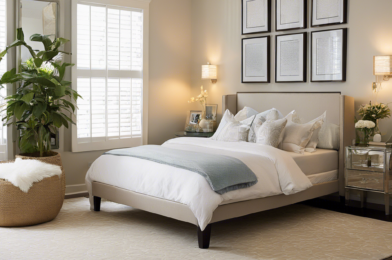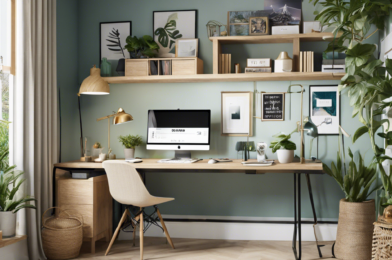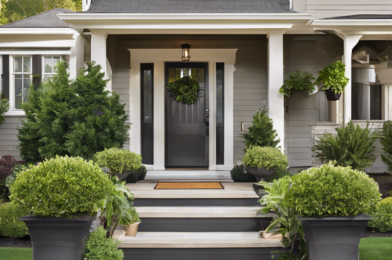Creating a beautiful and functional outdoor space can be a rewarding endeavor, adding curb appeal, value, and a sense of tranquility to your home. DIY landscaping is a popular trend, with many homeowners rolling up their sleeves and diving into garden transformations. Whether you’re a novice gardener or an experienced horticulturist, designing and crafting your own garden oasis is an achievable goal with careful planning and a bit of creativity.
The first step is to assess your yard and decide on a theme or style that appeals to you. Do you envision a lush, colorful garden with blooming florals, or perhaps a more minimalist, low-maintenance space with clean lines and structural interest? Maybe you’re drawn to the idea of a whimsical secret garden or a tranquil Japanese-inspired retreat. Defining your style will guide your plant choices, hardscaping elements, and overall layout.
Once you’ve established your vision, it’s time to get practical. Measure and map out your yard, taking note of sun exposure, existing plants, and the condition of the soil. This will help you select plants that thrive in your specific conditions and plan for any necessary improvements. Consider the functionality you desire – do you need entertaining areas, play spaces for children, or a quiet spot for relaxation and contemplation? Incorporating these features will make your outdoor space work for your lifestyle.
The right tools and some elbow grease will help you transform your yard. Prepare garden beds, amend the soil, and carefully plant your selections, ensuring they have adequate room to grow. Add mulch or gravel for a decorative touch and to suppress weeds. Finally, enjoy the satisfaction of bringing your garden oasis to life and the joy of spending time in your personalized outdoor sanctuary.
To enhance the overall aesthetics and functionality of your garden, consider incorporating hardscaping elements. Hardscaping refers to the non-living features that provide structure and definition to your outdoor space. Paths, patios, decks, and water features are all part of this. When designing your garden oasis, think about how you can use hardscaping to create a harmonious blend of natural and constructed elements. For example, a meandering path through a vibrant flower bed invites exploration, while a well-placed patio provides the perfect spot for outdoor dining or simply soaking up the sun.
The type of hardscaping you choose should align with the theme and style of your garden. For a rustic, country-style garden, consider using natural stone pavers or gravel paths that wind through lush plantings. In contrast, a modern, minimalist space might feature sleek concrete pavers and angular retaining walls. Water features, such as fountains or ponds, can add a soothing and tranquil element to your garden, creating a sense of calm and providing a focal point. When incorporated thoughtfully, hardscaping can define distinct areas within your garden, making it feel more purposeful and balanced.
One of the secrets to successful DIY landscaping is proper plant selection. Choosing the right plants for your specific conditions will ensure they thrive and minimize maintenance. Take into account your climate zone, sun exposure, and soil type when making your selections. Opt for a mix of trees, shrubs, perennials, and annuals to provide year-round interest and a diverse ecosystem for wildlife. Native plants are often a wise choice, as they are adapted to the local environment and require less watering and care.
When planning your plant combinations, consider the principle of “thriller, filler, and spiller.” This simple formula will help you create visually appealing container gardens or flower beds. Thrillers are the focal points – tall, dramatic plants that draw the eye. Fillers are medium-height plants that add bulk and texture, filling in any gaps. Spillers, as the name suggests, are trailing plants that soften the edges of containers or spill over walls and flower bed borders. Combining plants with these different habits creates instant impact and a well-designed look.
Don’t underestimate the power of color when selecting plants. Creating a cohesive color scheme will make your garden feel intentional and pleasing to the eye. You can choose to repeat a few complementary colors throughout your plantings or go for a monochromatic scheme for a stylish, modern look. Alternatively, embrace a rainbow of hues for a vibrant, cheerful space. Think about bloom times as well, ensuring you have a succession of color throughout the seasons to extend the visual interest.
As you design your garden oasis, it’s important to consider the practical aspects of maintenance. Opt for low-maintenance plants that are suited to your local conditions, as they will require less upkeep and be more resilient. Mulching your garden beds will help suppress weeds and retain moisture, reducing the need for frequent watering. Investing in efficient irrigation systems, such as drip lines or soaker hoses, will also minimize maintenance and ensure your plants receive the water they need without wasting resources.
Hardscaping choices can also impact maintenance levels. For example, choosing gravel or paving for paths and patios instead of grass will reduce the need for mowing and maintenance. Consider the size of your space and your lifestyle when designing – a smaller, well-designed garden can be just as enjoyable as a large one, requiring less time and effort to maintain. Keeping maintenance in mind during the planning stages will ensure your garden oasis remains a pleasure rather than a chore.
Incorporating sustainable practices into your DIY landscaping project is both environmentally friendly and cost-effective. Conservation methods such as rainwater harvesting can reduce your reliance on municipal water sources and lower your water bills. Collecting rainwater in barrels or tanks allows you to water your garden during drier periods, and it’s also beneficial for your plants, as rainwater is free of chemicals. Consider installing a rainwater collection system attached to your gutter downspout for a simple and efficient way to irrigate your garden.
When planning your garden oasis, don’t forget to include features that will attract and support local wildlife. Incorporating native plants is an excellent way to provide food and habitat for birds, butterflies, and beneficial insects. Opt for a variety of plant shapes and sizes to offer shelter and nesting sites. You can also add specific structures, such as birdhouses, bat boxes, or bee hotels, to encourage wildlife to make their homes in your garden. Creating a wildlife-friendly space will bring a sense of vitality and balance to your outdoor sanctuary.
As you design and create your garden oasis, remember that it’s a journey that will evolve over time. Embrace the process, and don’t be afraid to experiment and make changes along the way. Your garden is a reflection of your personal style and should bring you joy and a sense of accomplishment. So, step into the role of creator and curator of your outdoor space, and let your imagination and green thumb guide you. Happy gardening!






